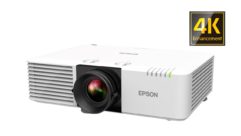
Epson PowerLite 77c
Sep 1, 2007 12:00 PM,
By Jeff Sauer
A simple, straightforward projector built for basic needs.

At a price of just $749 (I found it for less than $700 online), it’d be pretty easy to claim that Epson’s new PowerLite 77c is just about the most affordable projector currently available. Actually, Epson’s SVGA-resolution PowerLite S5 can be had for less than $600, and older SVGA models are even cheaper than that. Still, for a more current, native-XGA projector, the PowerLite 77c is a remarkable value. It also provides a nice snapshot of the state of front-projection technology.
Of course, that’s all part of the enormous price erosion that’s occurred in the front-projection industry over the last couple of years. The competition between the different front-projection image engine technologies has pushed prices down, and market share pressure from other display types, such as flatpanels, has swelled. But that’s all the better for the consumer — particularly the budget buyer. Imagine a projector, able to produce an image of up to 300in. diagonally, for roughly the same price as a quality desktop computer monitor. Talk about breaking barriers.
What do you get for such a low price? I tested Epson’s PowerLite 77c and found it, unsurprisingly, short on bells and whistles and quite average and inflexible in terms of picture quality. Still, today’s midland images are yesterday’s eye-poppers, and today’s run-of-the-mill features — such as auto-keystone — were headline news not so long ago. The bottom line is that without any new R&D features to amortize, Epson is able to offer a remarkable value to schools, small businesses, and other organizations looking for a straightforward large-screen display.
THE BASICS
If you need more than the bare bones for connection options, look elsewhere. The PowerLite 77c has just seven ports/jacks. There’s one data input, an analog 15-pin D-sub (buy a splitter cable, and you can bring in component video), and a 15-pin passthrough monitor out. There’s also S-Video and composite, as well as an RCA stereo audio pair and a USB port for remote mouse functionality. That’s it.
On the other hand, the large majority of users rarely connect more than one device at a time, particularly to a projector that’s likely to be moved from room to room and across an educational or business campus. At only 6lbs., the 77c is quite portable, and it includes Epson’s clever built-in sliding lens cover. It also includes a Kensington-style anchor bar for physically locking the unit down to prevent theft.
The handheld remote control is nothing special either, yet it’s functional, and it does include helpful presentation-oriented page up/down buttons in addition to the obvious menus and navigation controls. If you lose the remote (quite possible if the unit gets moved often), just about all the menus are available through the unit-top controls (not the page up/down keys), including a dedicated help button that walks inexperienced users through troubleshooting.
More importantly, the PowerLite 77c does include some of the very helpful tools that have emerged over the last few years to assist those less-experienced users get up and running quickly, and with a good, stable image. Quick indeed: Boot-up time is about 10 seconds, and the fan completely powers down after about 5 seconds once you’ve powered off the projector.
The auto-keystone function leverages a built-in level and, with the push of a single button, sets the vertical keystone correction to accommodate for overly tilted projection angles — provided that the tabletop is flat and level and the screen (or wall) is at a 90-degree angle. While this might seem superfluous to AV pros, Epson has also been very good over the years at auto-detecting sources and performing any positioning adjustments necessary to make a solid image — a feature that will afford the less-skilled user a good measure of comfort.
IMAGES: THE GOOD, BAD, AND UGLY
Of course, Epson has had to cut corners somewhere in order to achieve such a low price — if not leave reason for most users to buy more expensive models, right? Although you might be hard-pressed to see where those corners were cut if you use the 77c only as a basic presentation projector.
The 77c should be bright enough for most small-to-medium-size classrooms and conference rooms. Epson says 2200 lumens. I measured 1851 ANSI lumens averaged across the entire image in the brightest Presentation mode. That slightly-more-than-10-percent difference is, unfortunately, par for the course when it comes to marketing specifications. What I found more interesting — and pleasantly surprising — is that the brightness uniformity across the image was greater than 93 percent, yielding a nicely balanced image without a noticeable bright stop or dim edges. I also measured a contrast ratio of 355:1, slightly lower but not by a significant margin than Epson’s claim of 400:1, and it’s quite comparable to typical LCD panel numbers.
The 77c wasn’t bad when it comes to color reproduction, either. Admittedly, none of the three primary or three secondary colors plotted right on target, but they weren’t too far off either. Again, the result of that is color imagery that the average viewer would find quite appealing. It shows how far the industry has come at making a good picture standard fare. Grayscale tracking was similar, if yet another step downward. While the curve between about 30 IRE and 80 IRE was nice and smooth, below that there was a distinct shift toward blue, and above it a slightly less-dramatic — but more noticeable due to the light — shift toward red. Yet, again, for the average user and the typical educational or business usage, all of these caveats are probably just elitist quibbles.
The real trade-off for the price is in components that increase manufacturing costs, and in this case, that means scaling. At its native 1024×768 resolution, I could look at the 77c all day and be happy, but give it a non-native resolution of 1280×1024 or 800×600, and you’ll start to see artifacts — particularly in areas of fine detail and sharp edges. Higher-resolution sources are even worse, as are S-Video and composite video sources. Both problems are a result of ineffective image processing. Using a splitter cable to bring component video into the 15-pin works a little better, but that’s because it’s a clearer signal to begin with.
Does that make the PowerLite 77c a bad buy? Certainly not — at least not for everyone. It’s a remarkable value for classrooms and conference rooms that need to display basic information — be it spreadsheets, presentation slides, or other documents — and that’s particularly true if you can regularly feed in an XGA source. Heck, the same is true for the average LCD desktop monitor.
PRODUCT SUMMARY
Company: Epson
www.epson.com
Product: PowerLite 77c
Pros: Great price, good brightness and color.
Cons: Grayscale tracking a little weak, scaling is poor.
Price: $749 MAP
SPECIFICATIONS
Brightness: 2200 ANSI lumens
Contrast: 400:1 full on/off
Native resolution: 1024×768
Configuration: 3x LCD panels
Light source: E-TORL 170W UHE lamp
Lens: Manual focus, F= 1.6-1.74, f=18.4 – 22.12mm
Lens shift: 30° vertical
Projection distance: 4ft. to 28ft.
Screen size: 30in. to 300in. diagonally
Keystone: +/-30° vertical and horizontal
Loudspeakers: 1W monoaural
Dimensions: 12.9″×3.6″×9.6″ (W×H×D)
Weight: 6lbs.
Warranty: 2-year parts and labor









